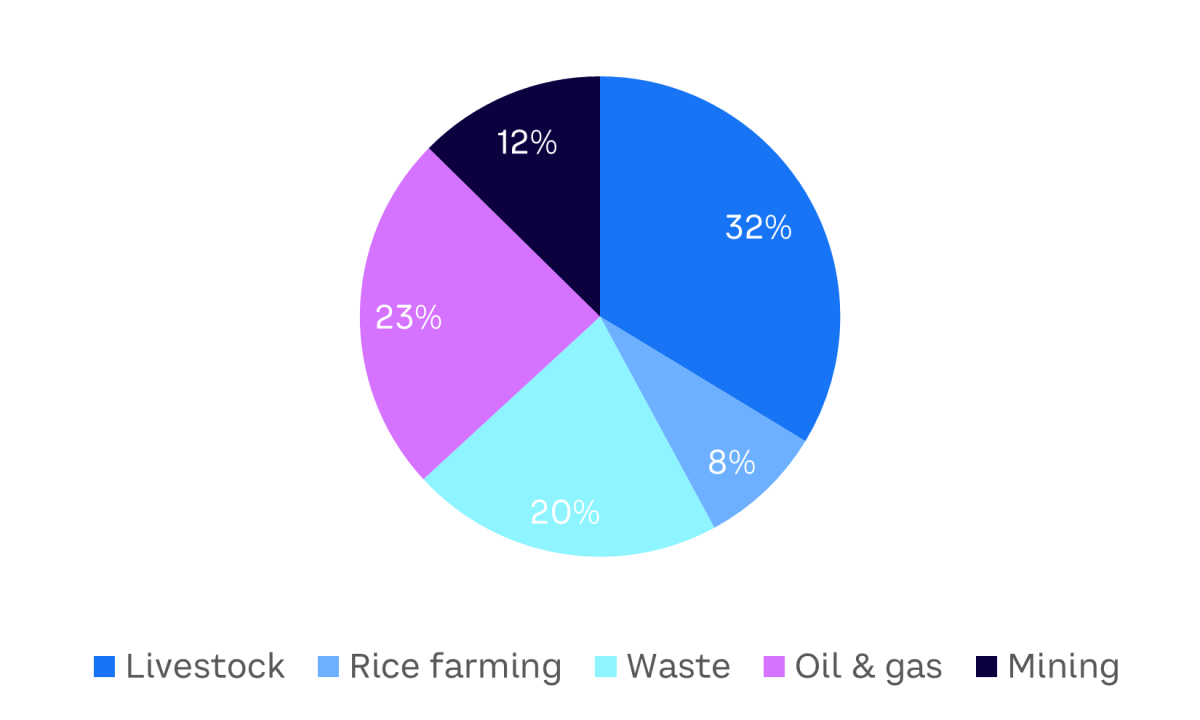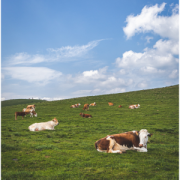Methane emissions are the second-largest cause of climate change after carbon dioxide. Sometimes referred to as the “other” hazardous greenhouse gas (GHG), methane has approximately 28 times the warming power of carbon dioxide. In addition to significantly impacting the environment, methane emissions also contribute to long-term health effects, including asthma, bronchitis, emphysema, and other respiratory illnesses.
Governments and companies worldwide are increasingly targeting methane emissions to further advanced their sustainability efforts as they seek to limit global warming. And the tech industry is devising new solutions to help organizations monitor and manage their methane emissions. This two-part Advisor series examines some of the recent developments in this area. Here in Part I, we look at efforts to reduce methane emissions in agriculture, the largest industry contributor (from human-related activities) to methane in the atmosphere.
A Little Background on Methane
Both natural and human activities contribute to methane released into the atmosphere. According to the “Global Methane Assessment” report from the United Nations Environment Programme (UNEP) and the Climate and Clean Air Coalition (CCAC), more than half of global methane emissions stem from human-related activities in three sectors (see Figure 1):
-
Agriculture — including livestock emissions and rice farming (40%)
-
Fossil fuels — including oil, gas, and mining (35%)
-
Waste — from landfills and water (20%)

The tech industry has responded with new, innovative solutions to assist companies in these different sectors in managing their methane emissions across their operations. These range from precision feed for livestock operations to digital platforms utilizing analytics, artificial intelligence (AI), and Internet of Things (IoT) technologies for remotely detecting and monitoring the impact of methane emissions on the environment.
Emission-Reduction Efforts in Agriculture
Livestock — including beef and dairy cows — is the largest contributor of methane from agricultural operations. And the biggest source of methane from cattle is not from flatulence but rather cow belching caused by enteric fermentation (the digestive process that produces methane as a by-product). Cow manure is also responsible for large amounts of methane, especially when it is collected in large ponds or tanks. Consequently, we are seeing considerable innovation in the form of new technology designed to control methane emanating from these sources.
GlasPort Bio
GlasPort Bio has taken a dual approach to livestock methane reduction. It has developed a food additive (RumenGlas) for cattle feed. Composed of natural ingredients, this feed additive targets methane-producing microbes within the rumen (i.e., the first compartment of the stomach of ruminant animals including cows, sheep, and goats) to help reduce methane emissions resulting from enteric fermentation. The company claims that the additive does not produce harmful residues or negatively impact the texture and taste of meat or milk.
GlasPort Bio is also developing another additive (GasAbate) to reduce methane and other gaseous emissions from stored cow manure. Company reps claim that laboratory tests indicate that by specifically targeting methane-emitting microbes, use of the additive can result in up to a 95% reduction in GHG emissions. An additional benefit of the additive is that it allows greater retention of important nutrients (e.g., nitrogen, sulphur, carbon) in treated manure, making it more useful as an organic fertilizer.
A key part of the GasAbate product development effort includes implementing an automated system designed to monitor methane emissions coming from manure storage sites, and, upon detection, releasing the GasAbate additive into the storage tank. In effect, the goal is to provide a fully automated remote-monitoring solution for managing manure storage.
ZELP
Livestock food additives are not the only way companies are trying to reduce methane emissions caused by cow belching. ZELP (Zero Emissions Livestock Project) is developing an IoT-connected wearable mask for cattle designed to neutralize methane while simultaneously monitoring the animal’s health and well-being.
The mask is constructed to fit comfortably around the cow’s head, basically covering just the animal’s nostrils. When the cow exhales, methane passes through a catalytic device and is oxidized and then released into the air in the form of CO2 and water vapor.
In addition, the masks are outfitted with sensors for tracking methane reduction and collecting key data on the animals. The data is analyzed in real time by a proprietary machine learning platform, which subsequently generates metrics and notifications pertaining to the animal’s health (e.g., exposure to heat, fertility state, signs of stress and disease). Farmers can view and interact with this information via the ZELP mobile app.
The mask’s use of energy-optimization technology is particularly interesting. Basically, the catalytic device features an energy-recovery system designed to capture the energy released from the methane-oxidation process. This energy is repurposed by the device, in effect, serving to help reduce the need for batteries to be recharged to power the cattle mask. The company claims that this feature gives its masks an operational life of approximately four years without requiring battery charging or replacement.
Regarding the impact on animals, ZELP says its masks are designed with “animal welfare at its core” and that independent studies conducted in Argentina and the UK indicate that animals wearing the masks showed “no changes in their behavior or in their cortisol levels, as well as no impact on their feeding habits or yields.”
Conclusion
Methane is a dangerous GHG that imperils the environment as well as the health of humans. Recognizing that agriculture is the largest industry contributor (from human-related activities) to methane in the atmosphere, governments and industry are stepping up their efforts to monitor and reduce emissions.
The applications and products examined in this Advisor are just a few of those available or in development. I’ve included them because I feel they represent some of the more innovative efforts involving the use of AI, analytics, wearables, precision agriculture, and other advanced technologies.
Part II of this series will examine new developments around reducing methane in the fossil fuel and waste industries. Until then, I’d like to get your thoughts on the use of technology for methane reduction and other sustainability efforts. As always, your comments will be held in strict confidence. You can email me at experts@cutter.com or call +1 510 356 7299 with your comments.



